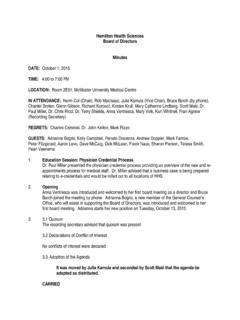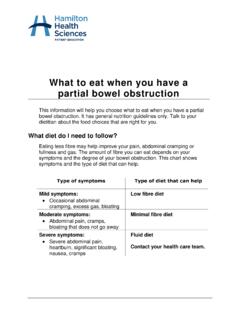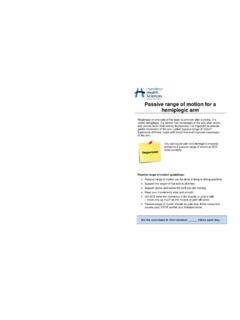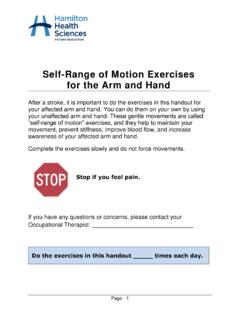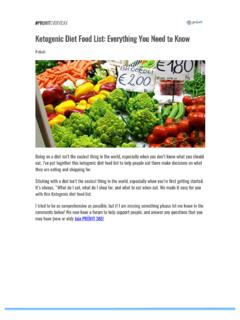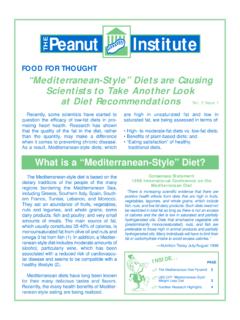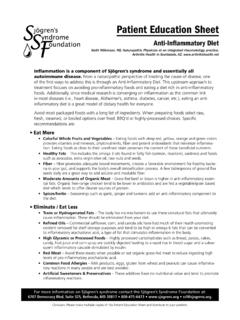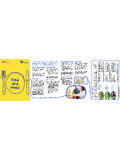Transcription of Non-Alcoholic Fatty Liver Disease (NAFLD); …
1 Managing nafld _____ 12 Hamilton Health Sciences, 2012 PD 7941 - 01/2016 dpc/ dt/January 5, 2016 Move your body How much exercise do I need? Studies show that exercise can decrease Liver fat. This includes both aerobic exercise (4 to 5 times a week) and resistance training (2 or more times a week). Health Canada recommends 30 to 60 minutes of exercise every day. To burn 150 calories, try one of these activities for 30 minutes: walk 2 miles ( km) cycle 3 miles ( km) water aerobics dance garden or rake the leaves Tips to be active: 1. Try different activities until you find the ones that are right for you. 2. Get into a routine with a friend Go to the pool, hit the gym, join a spin class or set a regular run and do some planned exercise.
2 Find a workout partner to encourage you and help keep you in a routine. 3. Limit the time you spend watching TV or sitting in front of a computer. 4. Just move Whenever you can, walk (like you are running late ), run or bike, instead of taking the car. 5. Spread your sessions of moderate to vigorous aerobic exercise throughout the week. Do at least 10 minutes of exercise at one time. 6. Join a team or group Take part in sports and recreation activities in groups. You will make new friends and get active at the same time. Managing Non-Alcoholic Fatty Liver Disease ( nafld ) What is Non-Alcoholic Fatty Liver Disease ( nafld )? nafld is the build-up of fat in the Liver in people who drink little or no alcohol. There are 2 types of nafld : Isolated Fatty Liver does not progress to Liver Disease Non-Alcoholic SteatoHepatitis (NASH) in which there is fat, inflammation and damage to Liver cells.
3 NASH can progress to cirrhosis (hardening and scarring of the Liver ). A few common symptoms with nafld are abdomen discomfort (in the Liver area), tiredness, and a general unwell feeling. A mild increase in blood Liver enzyme tests is also common. The most common cause of nafld is metabolic syndrome which includes obesity, diabetes and hyperlipidemia (high amount of fat in the blood). Fatty Liver occurs more often and is more severe as the level of obesity increases. There is no medication known to treat nafld . The treatment of nafld relates to the cause. If obesity is the cause of nafld , then the treatment is weight loss, along with eating healthy and exercise. If an individual has diabetes or hyperlipidemia, healthy types of fat and low calorie diet can improve blood sugar control and lower lipid levels.
4 Avoid alcohol as it can also cause Fatty Liver Disease . please turn over Managing nafld Managing nafld _____ _____ 2 11 Treatment for nafld Changing your lifestyle and diet can help improve your Liver function. Here are things you can do to help improve nafld : lose weight decrease intake of saturated fats and avoid trans fats eat healthy fats , especially omega -3 fats increase fibre intake decrease your intake of sugar and high fructose or high glucose containing beverages (see page 8 for more information) increase activity Weight loss is the most important change you can make to reduce fat in the Liver . My weight loss plan Weight loss and exercise are the most effective treatments for nafld . It does not take a large amount of weight loss.
5 Studies have shown that losing up to 10% of your weight (_____) can improve your Liver enzyme levels and decrease the amount of Liver fat. A healthy weight loss is 1 to 2 pounds per week. Rapid weight loss can worsen the Fatty Liver . To lose the 1 to 2 pounds of weight you need to burn 3,500 calories. To do this in one week you need to burn (see page 12 for more information) or decrease your caloric intake by 500 calories per day. Here are 2 key points to include in your weight loss plan: 1. Eating a well-balanced and healthy diet. The kind of foods you eat and how much you eat can affect your weight. 2. Move your body. Being physically active is also important. Meat and Alternatives 2 to 3 servings a day Foods group guidelines How much is one serving?
6 Say YES to Say NO to Eat at least 2 Food Guide servings of fish (with omega 3 fat) each week. Select lean meat and alternatives prepared with little or no added fat or salt. Have meat alternatives such as beans, lentils and tofu often. 2 oz cooked meat, poultry or fish. 2 eggs. 1/4 cup nuts or seeds 3/4 cup cooked legumes 2 tbsp peanut butter Lean cuts of meat with visible fat trimmed off such as strip loin or round. Skinless chicken or turkey. Egg whites or substitutes. omega 3 fish, especially Fatty fish such as salmon, sardines, trout, whitefish, herring, and mackerel Peas, beans and lentils Soy based meat alternatives such as tofu and textured vegetable protein (TVP) omega 3: flaxseeds, walnuts, soybeans and tofu Deep fried chicken wings or battered fish.
7 Meat with visible fat. Chicken or turkey with skin. Organ meats, Liver , kidney. Regular luncheon meat, bacon, sausage or hot dogs. More than 3 egg yolks each week. fats and oils - 2 servings a day Foods group guidelines How much is one serving? Say YES to Say NO to Healthy fats . Use unsaturated fats , such as olive oil, canola and vegetable. Limit intake of processed foods. 30 to 45 ml (2 to 3 tbsp) total amount of unsaturated fats and oils a day. omega 3: canola oil and soybean oil or margarines made with these oils : soft, non-hydrogenated margarine olive, canola, soybean, peanut and other vegetable oils Salad dressings such as oil and vinegar or low fat Regular sauces and gravies. Cream cheese, creamy salad dressings and full fat mayo.
8 Butter, cream, lard and shortening. Coconut or palm oil. Managing nafld Managing nafld _____ _____ 10 3 Vegetables and Fruits 7 to 10 servings a day Foods group guidelines How much is one serving? Say YES to Say NO to Eat at least one dark green and one orange vegetable each day. Enjoy vegetables and fruit prepared with little or no added fat, sugar or salt. Have vegetables and fruit more often than juice. 1 cup raw, leafy vegetable such as spinach 1/2 cup fresh, frozen, or canned vegetables or fruit 1/2 cup vegetable or fruit juice 1 medium sized piece of fruit All, except coconut and battered or deep fried vegetables. Coconut Battered or deep fried vegetables. Milk and Alternatives 2 to 3 servings a day Foods group guidelines How much is one serving?
9 Say YES to Say NO to Drink skim, 1% or 2% milk each day. Select lower fat milk alternatives, such as 20% MF or less cheese, and 0% MF yogurt. 1 cup milk or fortified soy beverage 3/4 cup yogurt 1 oz low fat cheese Skim or 1% milk, yogurt, cottage cheese Lower fat cheese (less than 20% MF) Low fat ice cream (1% MF), frozen yogurt (2% MF), sherbet Fortified soy beverages Full fat milk and dairy products Weight loss tips: 1. Keep track of your eating, activity and your mood. Use the diary in this handout to keep track of the food you eat, your level of activity and the mood you are in. This can help you spot patterns that need change. Review your diary once a week to help you see patterns that could be changed and tackle them one at a time.
10 2. Do not skip meals. Skipping meals may lead to unplanned snacking. These snacks are often high in calories. Try to eat at the same time every day, and choose nutritious snack foods like fresh fruit. 3. Always make a list before you go shopping. Stick to your list and shop on a full stomach so you will be less tempted to buy high-fat, high-calorie foods. 4. Plan to eat treat foods in moderation. Choose high-fat or high-calorie foods less often and in smaller portions. For example, try one scoop of ice cream instead of two. 5. Put less nutritious foods in hard-to-reach places. Store high-fat and high-calories foods in dark containers and put them out of reach. You will be less likely to eat these foods if they are hard to get.



